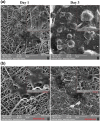Polycaprolactone/gelatin electrospun nanofibres containing biologically produced tellurium nanoparticles as a potential wound dressing scaffold: Physicochemical, mechanical, and biological characterisation
- PMID: 34694673
- PMCID: PMC8675828
- DOI: 10.1049/nbt2.12020
Polycaprolactone/gelatin electrospun nanofibres containing biologically produced tellurium nanoparticles as a potential wound dressing scaffold: Physicochemical, mechanical, and biological characterisation
Abstract
The biologically synthesised tellurium nanoparticles (Te NPs) were applied in the fabrication of Te NP-embedded polycaprolactone/gelatin (PCL/GEL) electrospun nanofibres and their antioxidant and in vivo wound healing properties were determined. The as-synthesised nanofibres were characterised using scanning electron microscopy (SEM), energy-dispersive X-ray (EDX) spectroscopy and elemental mapping, thermogravimetric analysis (TGA), and Fourier-transform infrared (FTIR) spectroscopy. The mechanical properties and surface hydrophobicity of scaffolds were investigated using tensile analysis and contact angle tests, respectively. The biocompatibility of the produced scaffolds on mouse embryonic fibroblast cells (3T3) was evaluated using MTT assay. The highest wound healing activity (score 15/19) was achieved for scaffolds containing Te NPs. The wounds treated with PCL/GEL/Te NPs had inflammation state equal to the positive control. Also, the mentioned scaffold represented positive effects on collagen formation and collagen fibre's horizontalisation in a dose-dependent manner. The antioxidative potency of Te NP-containing scaffolds was demonstrated with lower levels of malondialdehyde (MDA) and catalase (∼3 times) and a higher level of glutathione (GSH) (∼2 times) in PCL/GEL/Te NP-treated samples than the negative control. The obtained results strongly demonstrated the healing activity of the produced nanofibres, and it can be inferred that scaffolds containing Te NPs are suitable for wound dressing.
© 2021 The Authors. IET Nanobiotechnology published by John Wiley & Sons Ltd on behalf of The Institution of Engineering and Technology.
Conflict of interest statement
The authors declare no conflict of interest.
Figures











Similar articles
-
Bioactive anti-oxidative polycaprolactone/gelatin electrospun nanofibers containing selenium nanoparticles/vitamin E for wound dressing applications.J Biomater Appl. 2021 Aug;36(2):193-209. doi: 10.1177/08853282211001359. Epub 2021 Mar 15. J Biomater Appl. 2021. PMID: 33722085
-
Controlled release of lawsone from polycaprolactone/gelatin electrospun nano fibers for skin tissue regeneration.Int J Biol Macromol. 2019 Mar 1;124:478-491. doi: 10.1016/j.ijbiomac.2018.11.237. Epub 2018 Nov 27. Int J Biol Macromol. 2019. PMID: 30500508
-
Electrospun PCL/mupirocin and chitosan/lidocaine hydrochloride multifunctional double layer nanofibrous scaffolds for wound dressing applications.Int J Nanomedicine. 2018 Sep 10;13:5287-5299. doi: 10.2147/IJN.S177256. eCollection 2018. Int J Nanomedicine. 2018. PMID: 30237715 Free PMC article.
-
A Novel Bilayer Wound Dressing Composed of a Dense Polyurethane/Propolis Membrane and a Biodegradable Polycaprolactone/Gelatin Nanofibrous Scaffold.Sci Rep. 2020 Feb 20;10(1):3063. doi: 10.1038/s41598-020-59931-2. Sci Rep. 2020. PMID: 32080256 Free PMC article.
-
Development of Ag NPs/allantoin loaded PCL/GEL electrospun nanofibers for topical wound treatment.J Biomater Appl. 2023 Nov;38(5):692-706. doi: 10.1177/08853282231212605. Epub 2023 Oct 31. J Biomater Appl. 2023. PMID: 37905355
Cited by
-
Composite Polycaprolactone/Gelatin Nanofiber Membrane Scaffolds for Mesothelial Cell Culture and Delivery in Mesothelium Repair.Int J Mol Sci. 2024 Sep 11;25(18):9803. doi: 10.3390/ijms25189803. Int J Mol Sci. 2024. PMID: 39337295 Free PMC article.
-
PCL/Gelatin/Graphene Oxide Electrospun Nanofibers: Effect of Surface Functionalization on In Vitro and Antibacterial Response.Nanomaterials (Basel). 2023 Jan 25;13(3):488. doi: 10.3390/nano13030488. Nanomaterials (Basel). 2023. PMID: 36770449 Free PMC article.
-
Periodic Table of Immunomodulatory Elements and Derived Two-Dimensional Biomaterials.Adv Sci (Weinh). 2025 Feb;12(6):e2406324. doi: 10.1002/advs.202406324. Epub 2025 Jan 3. Adv Sci (Weinh). 2025. PMID: 39754328 Free PMC article. Review.
-
State-of-the-Art Review of Electrospun Gelatin-Based Nanofiber Dressings for Wound Healing Applications.Nanomaterials (Basel). 2022 Feb 25;12(5):784. doi: 10.3390/nano12050784. Nanomaterials (Basel). 2022. PMID: 35269272 Free PMC article. Review.
-
Evolving Trends in Nanofibers for Topical Delivery of Therapeutics in Skin Disorders.ACS Omega. 2023 May 18;8(21):18340-18357. doi: 10.1021/acsomega.3c00924. eCollection 2023 May 30. ACS Omega. 2023. PMID: 37273582 Free PMC article. Review.
References
-
- Ahmed, R. , et al.: Novel electrospun chitosan/polyvinyl alcohol/zinc oxide nanofibrous mats with antibacterial and antioxidant properties for diabetic wound healing. Int. J. Biol. Macromol. 120, 385–393 (2018) - PubMed
-
- Augustine, R. , et al.: Electrospun polycaprolactone membranes incorporated with Zno nanoparticles as skin substitutes with enhanced fibroblast proliferation and wound healing. Rsc. Adv. 4(47), 24777–24785 (2014)
-
- Akturk, O. , et al.: Wet electrospun silk fibroin/gold nanoparticle 3d matrices for wound healing applications. Rsc. Adv. 6(16), 13234–13250 (2016)
MeSH terms
Substances
Grants and funding
LinkOut - more resources
Full Text Sources
Other Literature Sources
Molecular Biology Databases
Miscellaneous

